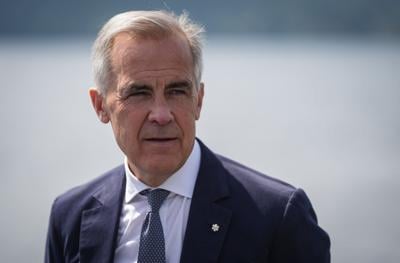OTTAWA — Prime Minister Mark Carney says that when it comes to charting Canada’s next steps through its volatile trade dispute with the U.S., he’s more focused on what he can control within Canada’s borders than the uncertainties outside them.
“We have always said that we would apply tariffs where they had the maximum impact in the United States and a minimum impact in Canada. And so we don’t automatically adjust, we look at what we can do for our industry that’s most effective,” Carney told reporters in Kelowna, B.C. on Tuesday.
The prime minister was responding to a question about how he could continue to project the “elbows-up” narrative he promoted throughout this spring’s federal election campaign, after U.S. President Donald Trump last week raised tariffs to 35 per cent on Canadian goods that don’t comply with the Canada-U.S.-Mexico Agreement (CUSMA). Trump signed that order after Canada and the U.S. failed to strike a new economic and security deal, maintaining sector-specific tariffs of 50 per cent on steel and aluminum and prompting calls from some, like Premier Doug Ford, for Carney to strike back.Â
Prime Minister Mark Carney was at a West Kelowna lumber mill to announce $1.2 billion in support for Canada's struggling softwood lumber. He promised that Canada will not play industries off against each for the sake of a trade deal with the U.S. (Aug. 5, 2025)
The Canadian PressCarney said his focus now is to “preserve” and “reinforce” CUSMA ahead of next year’s renegotiations, adding, “There’s a bigger picture there.”Â
He also said he hadn’t spoken to the U.S. president recently, and that the pair will connect “when it makes sense” to do so. Last Thursday, Trump told reporters that Carney had called him in the lead-up to Trump’s midnight deadline to reach a trade deal, but that the two leaders had not spoken.Â
Carney said that in some cases, the best course of action is to remove tariffs rather than retaliating with more.
“We have removed some tariffs over time, so that, for example, the auto industry can function more effectively, and we’ll look at opportunities to do so because, in the end, we’re looking at having the best impact in Canada,” the prime minister said.
That is a goal that “starts at home,” Carney said, as he announced $1.25 billion in new measures to support Canada’s softwood lumber industry, which is staring down a drastic hike in duties imposed by an increasingly protectionist White House.
The aid package includes $700 million in loan guarantees to ensure companies buffeted by trade pressures can “maintain and restructure” operations, and another $500 million, primarily in the form of grants, to make Canada’s softwood lumber sector more competitive and to boost domestic processing and production.
The prime minister also committed to altering federal procurement processes to require that companies entering contracts with Ottawa use Canadian lumber, a promise Carney tied to his pledge to spur the development of more homes and major resource and infrastructure projects. That comes on top of promises to diversify international exports of Canadian forest products and to set aside $50 million to train and support lumber workers battered by the changes.Â
“Over the course of the last four decades, the United States has alternated between confrontation and collaboration, frequently applying unfounded countervailing and anti-dumping duties against Canadian softwood and then signing formal agreements that benefited businesses, workers and homeowners on both sides of the border. Let’s be clear: Canada does not dump lumber into the United States, and we will continue to make the case that these current and proposed duties are unjustified,” Carney said.
“We’re in a situation now where the disputes around softwood lumber are part of a bigger picture,” the prime minister added. “American trade pressures have intensified and broadened. The U.S. is in the process of fundamentally changing all of its trading relationships.”
In late July, the U.S. Commerce Department hiked anti-dumping duties on Canadian softwood to 20.56 per cent. An expected boost to countervailing duties is expected to bring the combined duties faced by some companies to more than 34 per cent.Â
The U.S. has argued that Canadian softwood, a longtime trade irritant, is unfairly subsidized because of how timber taken from public land is priced, and that timber is being dumped into the U.S. at prices below fair market value.
“While securing a long-term agreement to resolve the ongoing trade dispute must remain a top national priority, these supports provide critical relief during an exceptionally challenging time,” the BC Council of Forest Industries wrote in a statement.
Carney said the majority of Canada’s lumber exports are destined for the U.S., leaving Canada “disproportionately exposed” to Washington’s whims.
“This dependence creates costly uncertainty. It weakens our industry’s ability to weather downturns,” he said.
While Ottawa’s small entourage of officials, including Canada-U.S. cabinet lead Minister Dominic LeBlanc, returned to Canada on Friday after failing to reach a deal, Carney said Tuesday that he will “continue to engage in constructive trade negotiations with the United States in the pursuit of the best deal for both sides.”
Meanwhile, Foreign Affairs Minister Anita Anand and Finance Minister François-Philippe Champagne arrived in Mexico City on Tuesday to strengthen ties with Mexican President Claudia Sheinbaum and business leaders.
Champagne, who said he had no line of sight into what countertariffs Carney could possibly remove, said Mexico, like Canada, has been engaging with Trump “strategically” and that he felt “no need to rush into” a potentially weaker deal.
When asked why Canada was unable to lock down the same 90-day extension to reach a deal as Mexico, Anand said the two situations cannot be compared.
“I want to stress that Canada’s economic relationship with the United States differs significantly from Mexico. We have over $2 billion of trade passing through the Canada-U.S. border every single day. And we also have different economic profiles, different levels of integration, and a long-standing economic and defense and security relationship that is perhaps the most integrated in the world,” Anand said.
“Therefore, to parse out individual elements of one country’s negotiations, versus our own, is somewhat superficial because the relationship is so very complex.”
Canada has been hit with 35 per cent tariffs after U.S. President Donald Trump followed through on his threat to increase the duties if Ottawa didn't make a trade deal. The White House has said the tariffs would not affect goods compliant with the Canada-U.S.-Mexico Agreement on trade, commonly known as CUSMA. Here's what that means for businesses in Canada. (Aug. 1, 2025)
The Canadian PressError! Sorry, there was an error processing your request.
There was a problem with the recaptcha. Please try again.
You may unsubscribe at any time. By signing up, you agree to our and . This site is protected by reCAPTCHA and the Google and apply.
Want more of the latest from us? Sign up for more at our newsletter page.































To join the conversation set a first and last name in your user profile.
Sign in or register for free to join the Conversation